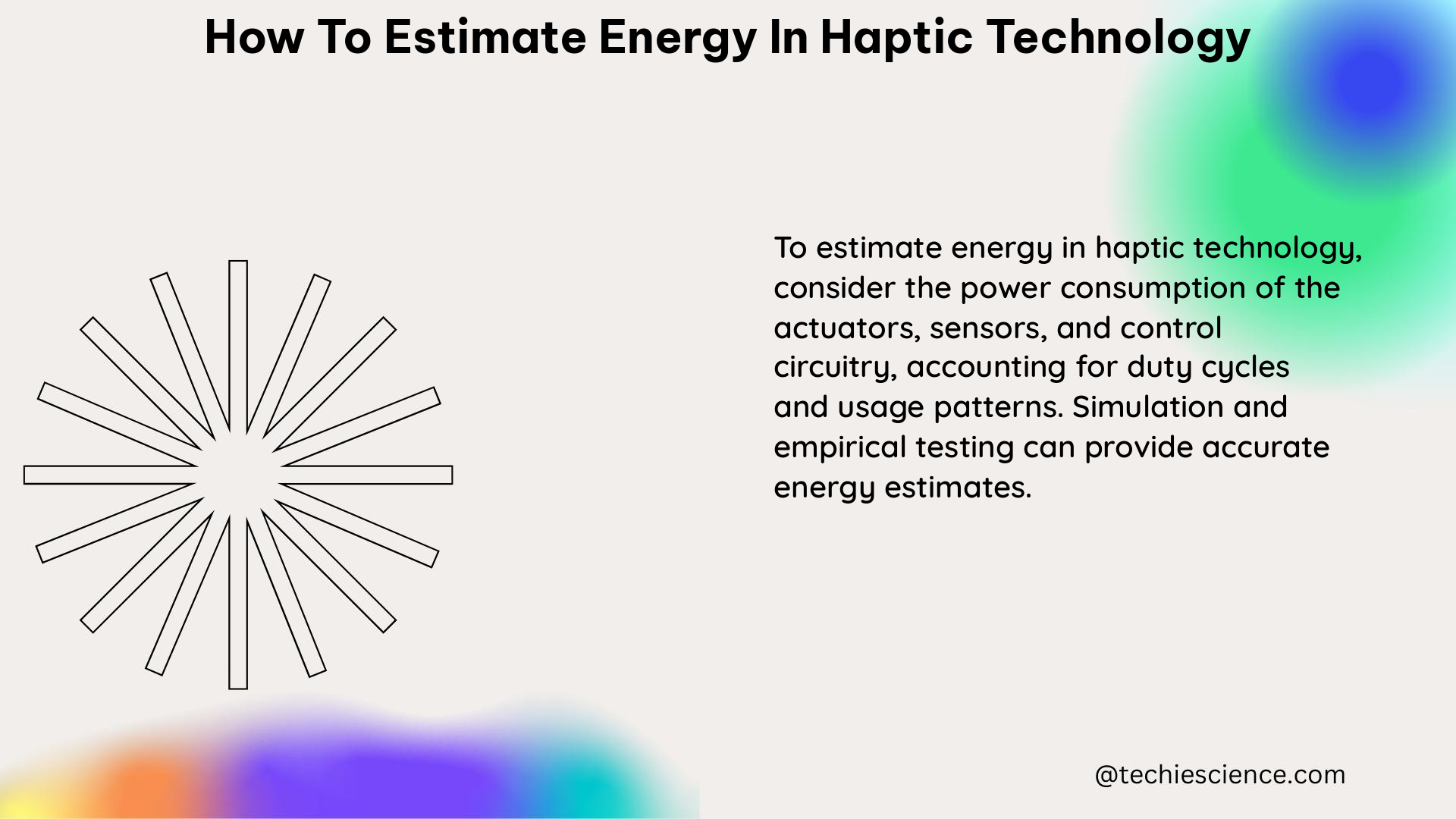Haptic technology has become increasingly prevalent in various applications, from smartphones to virtual reality systems. Accurately estimating the energy consumption of haptic systems is crucial for optimizing their performance, ensuring efficient power management, and enabling the development of more advanced and energy-efficient haptic devices. In this comprehensive guide, we will explore the key data points and techniques to estimate energy in haptic technology.
Workspace and Degrees of Freedom
Workspace Measurement
Accurately measuring the workspace of a haptic system is essential for understanding its capabilities and energy requirements. This can be done by using a ruler or measuring tape to determine the distances and angles within the system’s active and passive degrees of freedom.
- Active Degrees of Freedom: These are the actuated degrees of freedom that are crucial for providing haptic feedback. Measuring the range of motion and forces within these degrees of freedom is crucial for estimating energy consumption.
- Passive Degrees of Freedom: These are the non-actuated degrees of freedom that may still contribute to the overall energy consumption of the system, as they can affect the load on the actuators.
By quantifying the workspace and differentiating between active and passive degrees of freedom, you can gain valuable insights into the energy requirements of the haptic system.
Output Force and Motion

Output Force Measurement
Measuring the output force of a haptic system is essential for understanding its energy consumption and performance. To do this, you can use a force sensor with a resolution higher than the minimal desired force output resolution of the haptic system. This will allow you to measure static or quasi-static output force signals accurately.
- Peak Force: The peak force is the highest displayable force with a very low duration, limited by heat dissipation. Measuring the peak force can provide insights into the energy flux a device is capable of.
By measuring the output force, you can better understand the energy requirements of the haptic system and how it relates to the desired force feedback.
Energy Consumption
Current Consumption
Measuring the average current consumption of different actuators, such as Eccentric Rotating Mass (ERM), Linear Resonant Actuator (LRA), and Piezo Actuator, can help you compare their energy consumption. For example, the ERM may consume 124 mA, the LRA may consume 51.3 mA, and the Piezo may consume 62.6 mA at a peak acceleration of 0.9 g.
Energy Consumption Comparison
Comparing the energy consumption of different actuator technologies, such as ERM, LRA, and Piezo, in various scenarios, like smartphone applications, can provide valuable insights into the most energy-efficient solutions for your haptic system.
By measuring and comparing the current consumption of different actuators, you can make informed decisions about the most energy-efficient options for your haptic technology.
Performance Measures
Peak Force and Acceleration
Measuring the peak force and acceleration of a haptic system can help you evaluate the energy flux it is capable of. This information is crucial for understanding the system’s performance and energy requirements.
Frequency-Dependent Measurements
Analyzing the frequency-dependent performance of a haptic system, such as its frequency response, step response, and impulse response, can provide insights into its dynamic behavior and energy consumption. These measurements can help you optimize the system’s energy efficiency and performance.
Testing and Visualization
Laser Vibrometry
Utilizing laser vibrometers for non-contact haptics testing can be a powerful tool for quantifying and localizing haptic feedback, as well as for validating Finite Element (FE) models of haptic devices. Laser vibrometry can measure 1D and 3D motion data to describe the in-plane and out-of-plane vector components of haptic devices, providing valuable insights into their energy consumption and performance.
Actuator Technologies
Actuator Types
Evaluating different actuator technologies, such as ERM, LRA, and Piezo Actuator, for their energy consumption and performance is crucial for selecting the most energy-efficient solution for your haptic system. Each actuator type has its own unique characteristics and energy requirements, which must be carefully considered.
Energy Efficiency
Energy Efficiency in Portable Applications
In portable applications, such as smartphones and wearables, energy efficiency is a critical factor. Carefully considering the energy consumption of haptic systems in these scenarios can help you develop more energy-efficient and longer-lasting haptic devices.
By following the guidelines and techniques outlined in this comprehensive guide, you can effectively estimate the energy consumption of your haptic technology, enabling you to optimize performance, power management, and the development of advanced, energy-efficient haptic systems.
References
- https://www.linkedin.com/pulse/haptics-technology-market-2023-2030-analysis
- https://link.springer.com/chapter/10.1007/978-3-031-04536-3_13
- https://www.ti.com/lit/an/sloa194a/sloa194a.pdf?ts=1712985083469
- https://www.cim.mcgill.ca/~haptic/pub/VH-OA-ISRR-96.pdf
- https://www.polytec.com/us/vibrometry/areas-of-application/electronics-semiconductors-and-solar/haptic-displays

The lambdageeks.com Core SME Team is a group of experienced subject matter experts from diverse scientific and technical fields including Physics, Chemistry, Technology,Electronics & Electrical Engineering, Automotive, Mechanical Engineering. Our team collaborates to create high-quality, well-researched articles on a wide range of science and technology topics for the lambdageeks.com website.
All Our Senior SME are having more than 7 Years of experience in the respective fields . They are either Working Industry Professionals or assocaited With different Universities. Refer Our Authors Page to get to know About our Core SMEs.